
C13
.pdf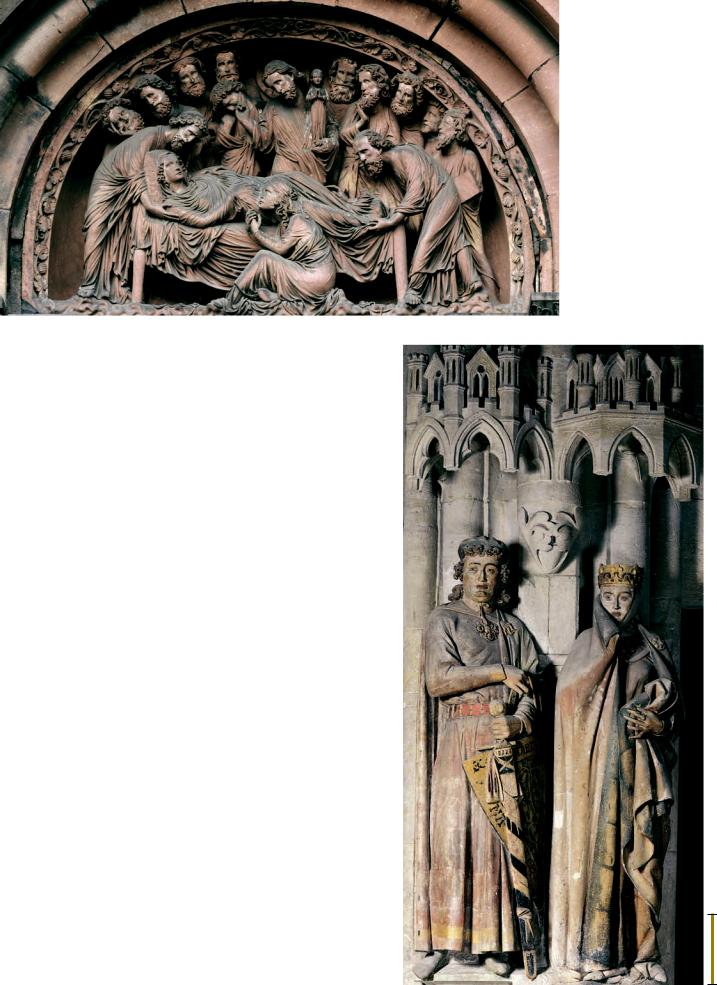
Virgin, forming an arc of mourners well suited to the semicircular frame. The sculptor adjusted the heights of the figures to fit the available space (the apostles at the right are the shortest), and, as in many depictions of crowds throughout history, some of the figures have no legs or feet. At the center, Christ receives his mother’s soul (the doll-like figure he holds in his left hand). Mary Magdalene, wringing her hands in grief, crouches beside the deathbed. The sorrowing figures express emotion in varying degrees of intensity, from serene resignation to gesturing agitation. The sculptor organized the group by dramatic pose and gesture but also by the rippling flow of deeply incised drapery that passes among the figures like a rhythmic electric pulse. The sculptor’s objective was to imbue the sacred figures with human emotions and to stir emotional responses in observers. In Gothic France, as already noted, art became increasingly humanized and natural. In Gothic Germany, artists carried this humanizing trend even further by emphasizing passionate drama.
EKKEHARD AND UTA The Strasbourg style, with its feverish emotionalism, was particularly appropriate for narrating dramatic events in relief. The sculptor entrusted with the decoration of the west choir of Naumburg Cathedral faced a very different challenge. The task was to carve statues of the 12 benefactors of the original 11th-century church on the occasion of a new fundraising campaign. The vivid gestures and agitated faces in the Strasbourg tympanum contrast with the quiet solemnity of the Naumburg statues. Two of the figures (FIG. 13-49) stand out from the group because of their exceptional quality. They represent the margrave (military governor) Ekkehard II of Meissen and his wife Uta. The statues are attached to columns and stand beneath architectural canopies, following the pattern of French Gothic portal statuary. Their location indoors accounts for the preservation of much of the original paint. Ekkehard and Uta suggest the original appearance of the facade and transept sculptures of Gothic cathedrals.
13-49 Ekkehard and Uta, statues in the west choir, Naumburg Cathedral, Naumburg, Germany, ca. 1249–1255. Painted limestone, Ekkehard 6 2 high.
The period costumes and individualized features of these donor portraits give the impression that Ekkehard and Uta posed for their statues, but they lived long before the Naumburg sculptor’s time.
13-48 Death of the Virgin, tympanum of left doorway, south transept, Strasbourg Cathedral, Strasbourg, France, ca. 1230.
Stylistically akin to the
Visitation group (FIG. 13-24, right) of Reims Cathedral, the figures in Strasbourg’s southtransept tympanum express profound sorrow through dramatic poses and gestures.
1 ft.
Gothic Outside of France |
369 |
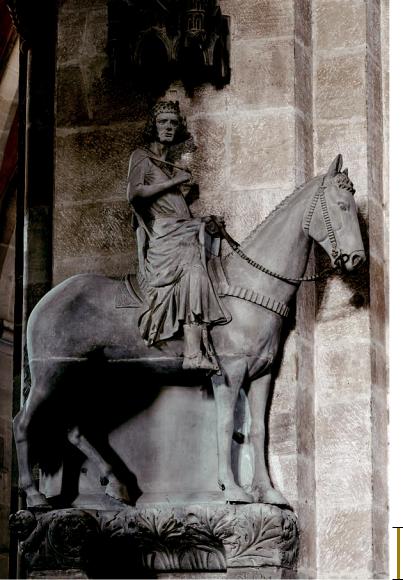
13-50 Equestrian portrait (Bamberg Rider), statue in the east choir, Bamberg Cathedral, Germany, ca. 1235–1240. Sandstone, 7 9 high.
Probably a portrait of a German emperor, perhaps Frederick II, the Bamberg Rider revives the imagery of the Carolingian Empire. The French-style architectural canopy cannot contain the entire statue.
The period costumes and the individualized features and personalities of the margrave and his wife give the impression that they posed for their own portraits, although the subjects lived well before the sculptor’s time. Ekkehard, the intense knight, contrasts with the beautiful and aloof Uta. With a wonderfully graceful gesture, she draws the collar of her gown partly across her face while she gathers up a soft fold of drapery with a jeweled, delicate hand. The sculptor subtly revealed the shape of Uta’s right arm beneath her cloak and rendered the fall of drapery folds with an accuracy that indicates the use of a model. The two statues are arresting images of real people, even if they bear the names of aristocrats the artist never met. By the mid-13th century, in the Holy Roman Empire as well as in England (FIG. 13-44) and elsewhere, life-size images of secular personages had found their way into churches.
BAMBERG RIDER Somewhat earlier in date than the Naumburg “portraits” is the equestrian statue known as the Bamberg Rider (FIG. 13-50). For centuries this statue has
been mounted against a pier in Bamberg Cathedral beneath an architectural canopy that frames the rider’s body but not his horse. Scholars debate whether the statue was made for this location or moved there, perhaps from the church’s exterior. Whatever the statue’s original location, it revives the imagery of the Carolingian Empire (FIG. 11-12), derived in turn from that of ancient Rome (FIG. 7-59).
Like Ekkehard and Uta, the Bamberg Rider seems to be a true portrait. Some believe it represents a Holy Roman emperor, perhaps Frederick II (r. 1220–1250), who was a benefactor of Bamberg Cathedral. The many other identifications include Saint George and one of the three magi, but a historical personality is most likely the subject. The presence of a Holy Roman emperor in the cathedral would have underscored the unity of church and state in 13th-century Germany. The artist carefully represented the rider’s costume, the high saddle, and the horse’s trappings. The proportions of horse and rider are correct, although the sculptor did not quite understand the animal’s anatomy, so its shape is rather stiffly schematic. The rider turns toward the observer, as if presiding at a review of troops. The torsion of this figure seems to reflect the same impatience with subordination to architecture found in the Reims portal statues (FIG. 13-24).
RÖTTGEN PIETÀ The confident 13th-century figures at Naumburg and Bamberg stand in marked contrast to a haunting 14thcentury German painted wooden statuette (FIG. 13-51) of the Virgin
370 Chapter 13 G OT H I C E U RO P E
1 ft.
Mary holding the dead Christ in her lap. The widespread troubles of the 14th century—war, plague, famine, and social strife—brought on an ever more acute awareness of suffering. This sensibility found its way readily into religious art. The Dance of Death, Christ as the Man of Sorrow, and the Seven Sorrows of the Virgin Mary became favorite themes. A fevered and fearful piety sought comfort and reassurance in the reflection that Christ and the Virgin Mother shared humanity’s woes. To represent this, artists emphasized the traits of human suffering in powerful, expressive exaggeration. In the illustrated group, a Pietà (“pity” or “compassion” in Italian), the sculptor portrayed Christ as a stunted, distorted human wreck, stiffened in death and covered with streams of blood gushing from a huge wound. The Virgin Mother, who cradles him like a child in her lap, is the very image of maternal anguish, her oversized face twisted in an expression of unbearable grief. This statue expresses nothing of the serenity of Romanesque and earlier Gothic depictions of Mary (FIGS. 12-18 and 13-16). Nor does the Röttgen Pietà (named after a collector) have anything in common with the aloof, iconic images of the Theotokos with the infant Jesus in her lap common in Byzantine art (FIGS. 9-18 and 9-19). Here the artist forcibly confronts the devout with an appalling icon of agony, death, and sorrow that humanizes, lmost to the point of heresy, the sacred personages. The work calls out to the horrified believer, “What is your suffering compared to this?”
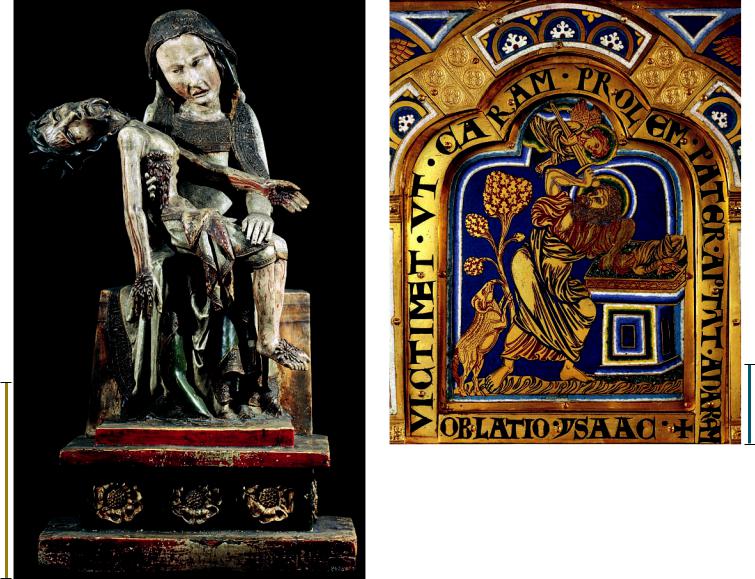
1 ft.
13-51 Virgin with the Dead Christ (Röttgen Pietà), from the Rhine-
land, Germany, ca. 1300–1325. Painted wood, 2 10 – high. Rheinisches
1
2
Landemuseum, Bonn.
This statuette of the Virgin grieving over the distorted dead body of Christ in her lap reflects the widespread troubles of the 14th century and the German interest in emotional imagery.
Throughout Europe, the humanizing of religious themes and religious images accelerated steadily from the 12th century. By the 14th century, art addressed the private person (often in a private place) in a direct appeal to the emotions. The expression of feeling accompanied the representation of the human body in motion. As the figures of the church portals began to twist on their columns, then move within their niches, and then stand independently, their details became more outwardly related to the human audience as expressions of recognizable human emotions.
NICHOLAS OF VERDUN As part of his plan to make his new church at Saint-Denis an earthly introduction to the splendors of Paradise (see “Abbot Suger,” page 341), Suger selected artists from the Meuse River valley to fashion a magnificent crucifix for the choir. This region long had been famous for the quality of its metalworkers and enamelers (FIGS. 12-23 and 12-24). Suger described the SaintDenis cross as standing on a sumptuous base decorated with 68
1 in.
13-52 NICHOLAS OF VERDUN, sacrifice of Isaac, detail of the Klosterneuburg Altar, from the abbey church at Klosterneuburg, Austria, 1181.
Gilded copper and enamel, 5 – high. Stiftsmuseum, Klosterneuburg.
1
2
Nicholas of Verdun was the leading artist of the Meuse valley region, renowned for its metaland enamelwork. His emotionally charged gold figures stand out vividly from the blue enamel background.
enamel scenes pairing Old and New Testament episodes. The enamel work of the leading Meuse valley artist of the late 12th and early 13th centuries, NICHOLAS OF VERDUN, suggests the appearance of the biblical enamels on Suger’s lost crucifix.
In 1181, Nicholas completed work on a gilded-copper and enamel ambo (a pulpit for biblical readings) for the Benedictine abbey church at Klosterneuburg, near Vienna in Austria. After a fire damaged the pulpit in 1330, the church hired artists to convert the pulpit into an altarpiece (a decorative panel above and behind the altar). The pulpit’s sides became the wings of a triptych (three-part altarpiece). The 14th-century artists also added six scenes to Nicholas’s original 45. The Klosterneuburg Altar in its final form has a central row of enamels depicting New Testament episodes, beginning with the Annunciation, and bearing the label sub gracia, or the world “under grace,” that is, after the coming of Christ. The upper and lower registers contain Old Testament scenes labeled, respectively, ante legem, “before the law” Moses received on Mount Sinai, and sub lege, “under the law” of the Ten Commandments. In this scheme, prophetic Old Testament events appear above and below the New Testament episodes they prefigure. For example, framing the Annunciation to Mary of the coming birth of Jesus are enamels of angels announcing the births of Isaac and Samson. In the central section of the triptych, the Old Testament counterpart of Christ’s Crucifixion is Abraham’s sacrifice of Isaac (FIG. 13-52), a parallel already established in Early Christian times in both art (FIG. 8-7)
Gothic Outside of France |
371 |
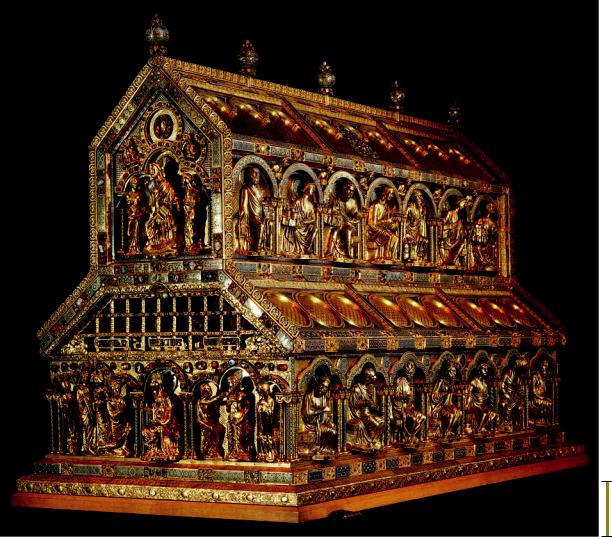
1 ft.
13-53 NICHOLAS OF VERDUN, Shrine of the Three Kings, from Cologne Cathedral, Cologne, Germany, begun ca. 1190. Silver, bronze, enamel, and gemstones, 5 8 6 3 8 . Cathedral Treasury, Cologne.
Cologne’s archbishop commissioned this huge reliquary in the shape of a church to house relics of the three magi. The figures are sculpted versions of those on the Klosterneuburg Altar (FIG. 13-52).
and literature (see “Jewish Subjects in Christian Art,” Chapter 8, page 213). Nicholas of Verdun’s gold figures stand out vividly from the blue enamel background. The biblical actors twist and turn, make emphatic gestures, and wear garments that are almost overwhelmed by the intricate linear patterns of their folds. In the Abraham and Isaac panel, the angel flies in at the very last moment to grab the blade of Abraham’s sword before he can kill the bound Isaac on the altar. The intense emotionalism of the representation and the linear complexity of the garments foreshadowed the tone and style of the Strasbourg tympanum depicting the death of the Virgin (FIG. 13-48).
Sculpted versions of the Klosterneuburg figures appear on the
Shrine of the Three Kings (FIG. 13-53) in Cologne Cathedral. Nicholas of Verdun probably began work on the huge reliquary (six feet long and almost as tall) in 1190. Philip von Heinsberg, archbishop of Cologne from 1167 to 1191, commissioned the shrine to contain relics of the three magi. The Holy Roman Emperor Frederick Barbarossa acquired them in the conquest of Milan in 1164 and
donated them to the German cathedral. Possession of the magi’s relics gave the Cologne archbishops the right to crown German kings. Nicholas’s reliquary, made of silver and bronze with ornamentation in enamel and gemstones, is one of the most luxurious ever fashioned, especially considering its size. The shape resembles that of a basilican church. Repoussé figures of the Virgin Mary, the three magi, Old Testament prophets, and New Testament apostles in arcuated frames are variations of those on the Klosterneuburg pulpit. The deep channels and tight bunches of the drapery folds are hallmarks of Nicholas’s style.
Nicholas of Verdun’s Klosterneuburg Altar and his Shrine of the Three Kings, together with Suger’s treatises on the furnishings of Saint-Denis, are welcome reminders of how magnificently outfitted medieval church interiors were. The so-called minor arts played a defining role in creating a special otherworldly atmosphere for Christian ritual. These Gothic examples continued a tradition that dates to the Roman emperor Constantine and the first imperial patronage of Christianity (see Chapter 8).
372 Chapter 13 G OT H I C E U RO P E
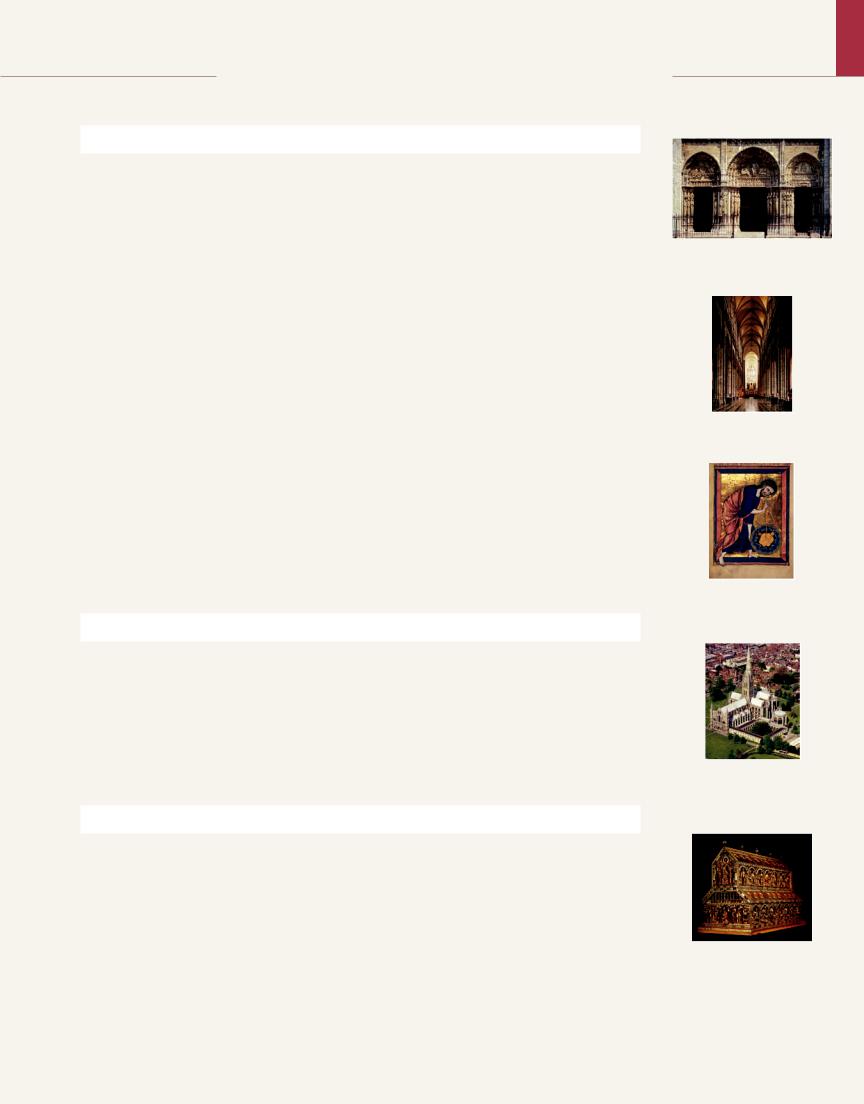
T H E B I G P I C T U R E
G O T H I C E U R O P E
FRANCE
The birthplace of Gothic art and architecture was Saint-Denis, where Abbot Suger used rib vaults with pointed arches and stained-glass windows to rebuild the Carolingian royal church. The west facade of Suger’s church also introduced statue-columns on the portal jambs, which appeared shortly later on the Royal Portal of Chartres Cathedral. Laon Cathedral is another important example of Early Gothic (1140–1194) architecture.
Royal Portal, Chartres Cathedral,
After a fire in 1194, Chartres Cathedral was rebuilt with flying buttresses, four-part nave vaults, and ca. 1145–1155 a three-story elevation of nave arcade, triforium, and clerestory, setting the pattern for High Gothic
(1194–1300) cathedrals, including Amiens with its 144-foot-high vaults.
Flying buttresses made possible huge stained-glass windows. High Gothic windows employ delicate lead cames and bar tracery. The divine colored light (lux nova) they admitted transformed the character of church interiors.
High Gothic statue-columns broke out of the architectural straitjacket of their Early Gothic predecessors. At Chartres, Reims, and elsewhere, the sculpted figures move freely and sometimes converse with their neighbors.
Amiens Cathedral, begun 1220
The High Gothic Rayonnant court style of Louis IX gave way in the Late Gothic (1300–1500) period to the Flamboyant style seen at Saint-Maclou at Rouen.
Several important examples of secular architecture survive from the Gothic period, including the bastions and towers of Carcassonne, the hall of the cloth guild in Bruges, and the house of Jacques Coeur in Bourges.
In the 13th century, Paris was the center of production of costly moralized Bibles and other illuminated manuscripts in urban workshops of professional artists, which usurped the role of monastic scriptoria.
God as architect of the world, ca. 1220–1230
ENGLAND
The Parisian Gothic style became the rage in most of Europe during the 13th century, but many regional styles developed, as in the Romanesque period. English Gothic churches like Salisbury Cathedral differ from their French counterparts in their wider and shorter facades, flat east ends, double transepts, and sparing use of flying buttresses.
Especially characteristic of English Gothic architecture is the elaboration of architectural patterns, which often disguise the underlying structure of the buildings. Constructed in the Late Gothic Perpendicular style, the fan vaults of the chapel of Henry VII transform the logical rib vaults of French buildings into decorative fancy.
HOLY ROMAN EMPIRE
German architects eagerly embraced the French Gothic architectural style at Cologne Cathedral and elsewhere. German originality manifested itself most clearly in the Gothic period in sculpture, which often features emotionally charged figures in dramatic poses.
Statues of secular historical figures decorate the interiors of Naumburg and Bamberg cathedrals, signaling a revival of interest in the art of portraiture.
Nicholas of Verdun was the leading artist of the Meuse River valley, an area renowned for metaland enamelwork. Nicholas’s altars and shrines provide an idea of how sumptuous were the furnishings of Gothic churches.
Salisbury Cathedral, Salisbury,
1220–1258
Nicholas of Verdun,
Shrine of the Three Kings, ca. 1190
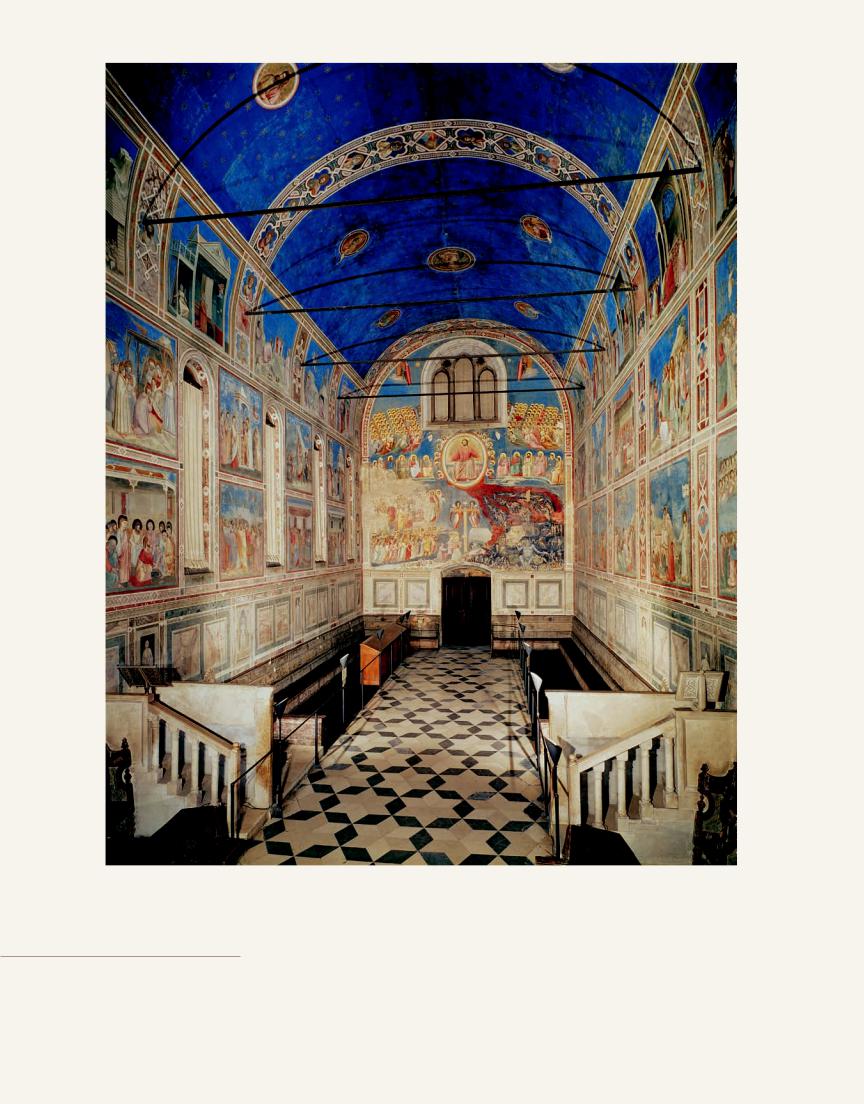
14-1 GIOTTO DI BONDONE, Arena Chapel (Cappella Scrovegni; interior looking west), Padua, Italy, 1305–1306.
Giotto, widely regarded as the first Renaissance painter, was a pioneer in pursuing a naturalistic approach to representation based on observation. The frescoes in the Arena Chapel show his art at its finest.
